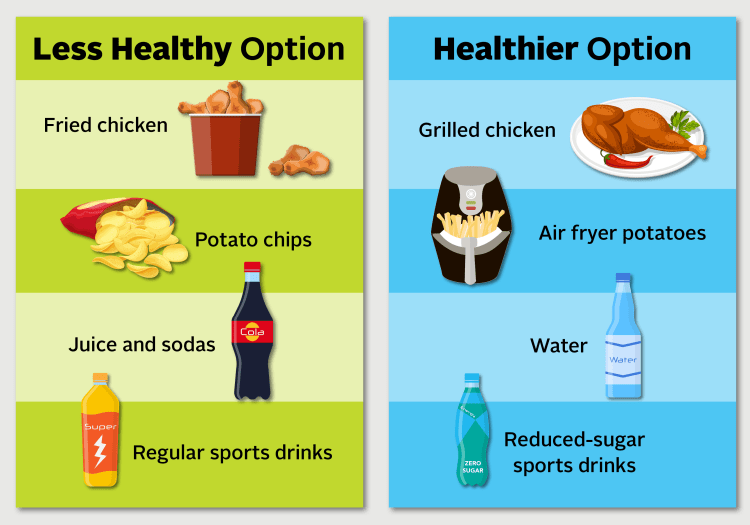Diabetes diet
Creating healthy eating plans for kids and adults.
Article Date:

According to the American Diabetes Association (ADA), approximately 34 million children and adults in the U.S. have diabetes.
There are two major types:
- Type 1 occurs when the body doesn’t produce insulin, a hormone that allows blood sugar to get into cells to use for energy. This type is generally unrelated to obesity and can strike otherwise healthy individuals.
- Type 2 is the most common form of diabetes in adults but also occurs in children. It develops when the body produces insulin but doesn’t respond to it properly, meaning someone is resistant to its effects. Eventually, the body can’t produce enough insulin. People who are overweight or inactive are more likely to develop Type 2 diabetes.
Diabetes experts say dietary changes can help manage the disease, regardless of which type a person has. As always, talk with your doctor first before making any changes to your diet.
Caring for kids
When coaching children with diabetes, clinical dietitians at the Northeast Florida Pediatric Diabetes Center at Wolfson Children’s Hospital and Nemours Children’s Health, Jacksonville, emphasize that change is a gradual process.
“A lot of small steps can make a big difference,” said Bethany Grant, a registered dietician and diabetes educator. “For anyone with diabetes, regardless of type, the goal is to promote a lifestyle of healthy eating, not so much a ‘diabetic diet.’”
Type 1
The team at the Pediatric Diabetes Center educates children and families with Type 1 diabetes about the difference between carbohydrates, fats and proteins. Patients and families also learn how to count carbs and watch their sugar consumption so they can manage the amount of insulin needed from either a pump or injections.
“Roughly 40-50% of their diet should be carbohydrates,” said Mary Louise Fox, registered dietician and diabetes educator. “There is no number limit on carbs, but these patients need to check the serving size on nutrition labels and ensure they are portioning their food appropriately.”
Children with Type 1 diabetes should look for opportunities to make the same healthy food swaps as kids with Type 2 diabetes (see chart below), and they should try to avoid junk food and saturated fats.
Type 2
The focus for children with Type 2 diabetes is lifestyle changes including exercise and weight loss, with an emphasis on choosing healthier options over high-fat foods and homemade meals instead of fast food. Here are some examples:

They also give patients with Type 2 diabetes a plate to take home that has recommended serving sizes for each meal. The plate should be half filled with vegetables, one-quarter protein and one-quarter starch.
“Most importantly, kids and families should realize they are not alone,” Fox said. “We frequently reassess our patients to make sure we are finding strategies that work for them.”
Adjustments for adults
Casey Bonaquist, DO, a family physician and obesity medicine specialist with Baptist Primary Care, said much of the guidance is similar for adults with both types of diabetes.
“A good rule of thumb for people with Type 1 diabetes, and anyone striving to live an overall healthy lifestyle, is to avoid processed foods and high sugar foods,” Dr. Bonaquist said. “Added sugars can often be found in packaged and prepared foods.”
Dr. Bonaquist said eating sugary foods, even in moderation, is going to lead you to crave more sugar.
“It’s a cycle that’s hard to break and makes maintaining a healthy diet difficult. If you wean yourself off of added sugars, your body will eventually stop craving them, and you’ll feel more in control.”
Type 1
Dr. Bonaquist said patients with Type 1 diabetes typically work with an endocrinologist and a dietitian to help manage their medications and diet.
Type 2
For patients with Type 2 diabetes, certain medications can cause blood sugar to go too low with major diet changes. It is important to review diet changes with your doctor first.
Since Type 2 diabetes management can improve with lifestyle changes, Dr. Bonaquist also recommended adults maintain a food log to keep track of what they are choosing to eat.
“This is a helpful tool to encourage people to be more mindful about their eating habits; are they eating because they are bored or stressed, or because they are actually hungry?” Dr. Bonaquist said.
To set up an appointment with the Pediatric Diabetes Center, call 904.202.8547 or visit wolfsonchildrens.com/diabetes.
If you’re concerned about your child having diabetes, talk to their pediatrician.
If you’re concerned about diabetes and want to get screened, make an appointment with a Baptist Primary Care physician near you by calling 904.202.4YOU or filling out this form. Your primary care physician can help guide you through the next steps.


